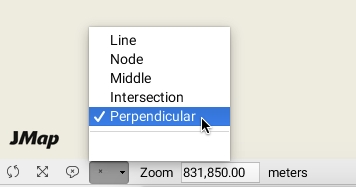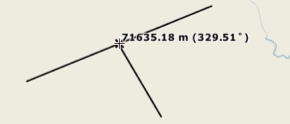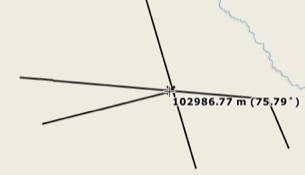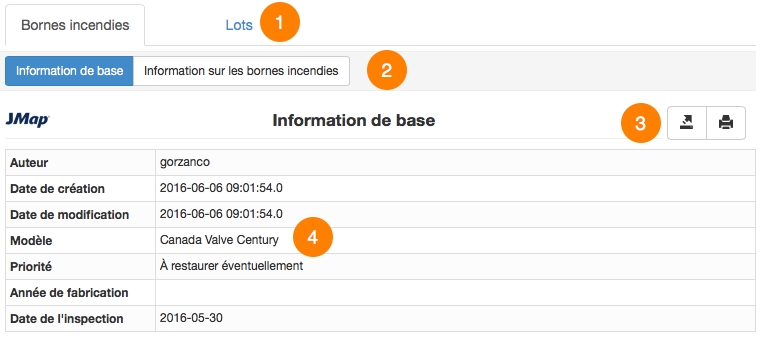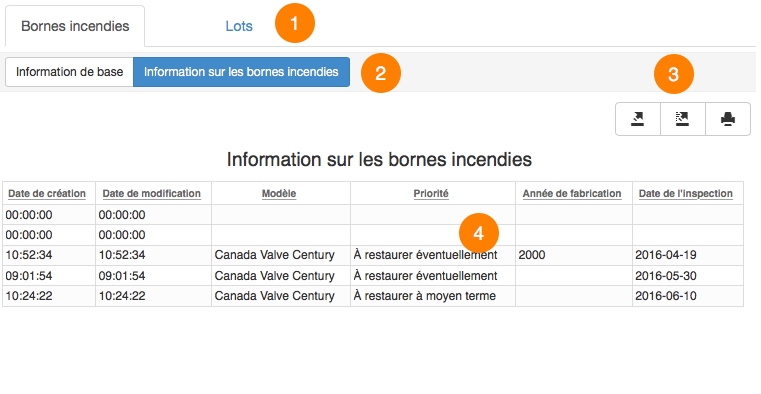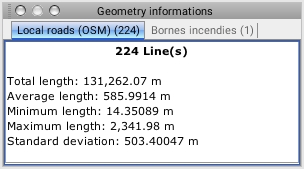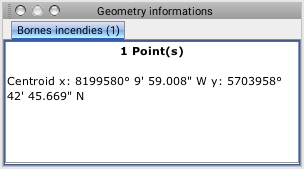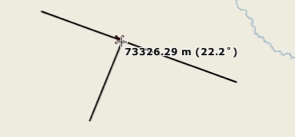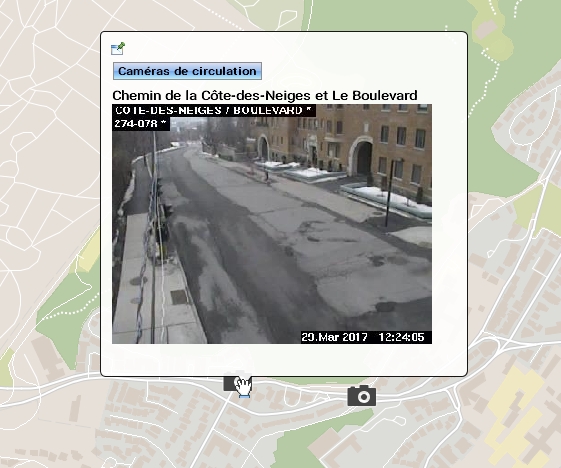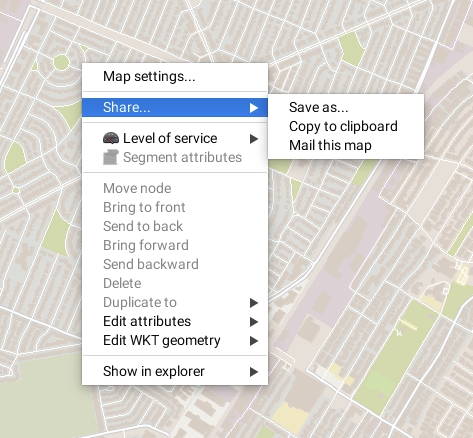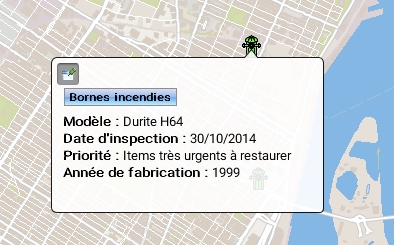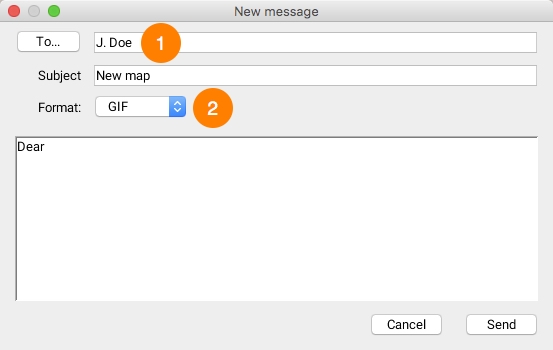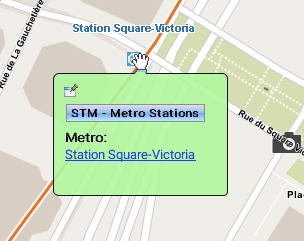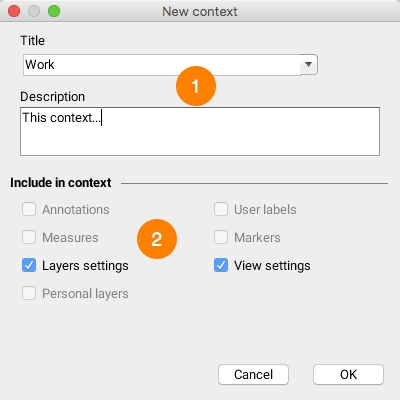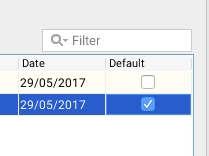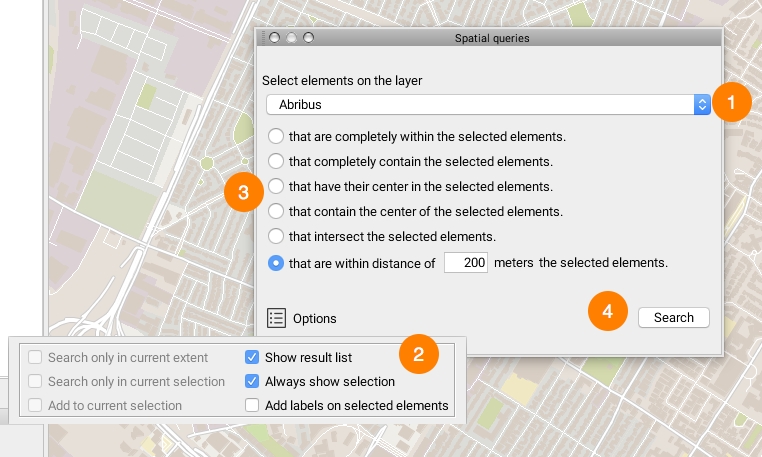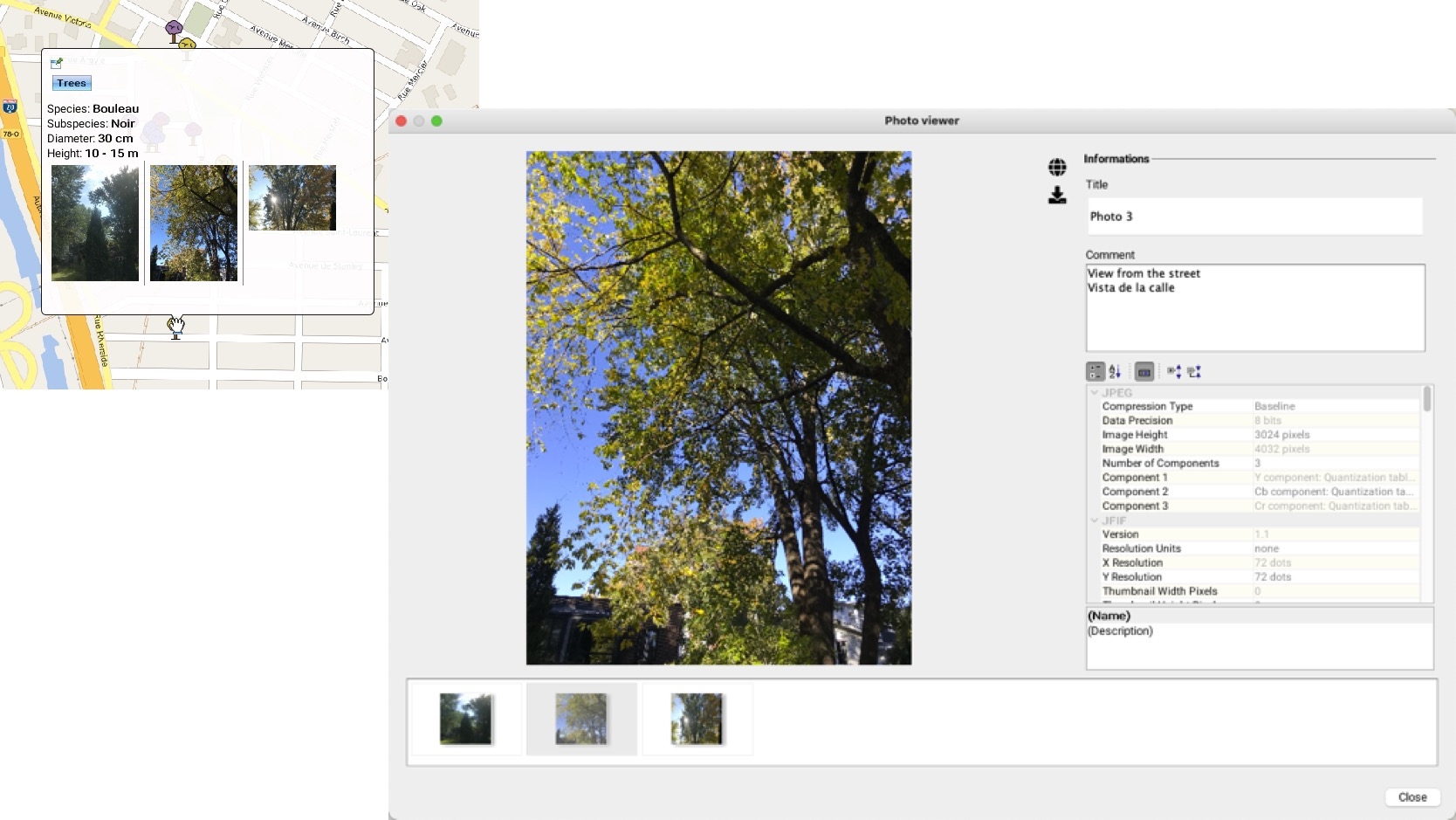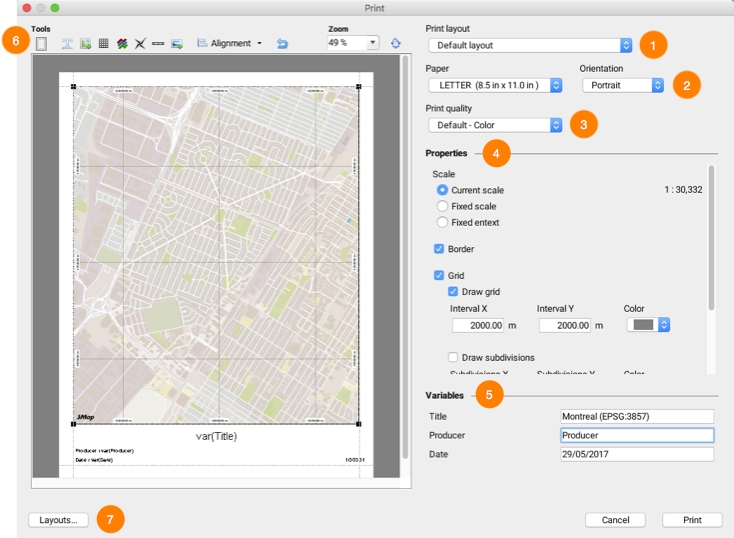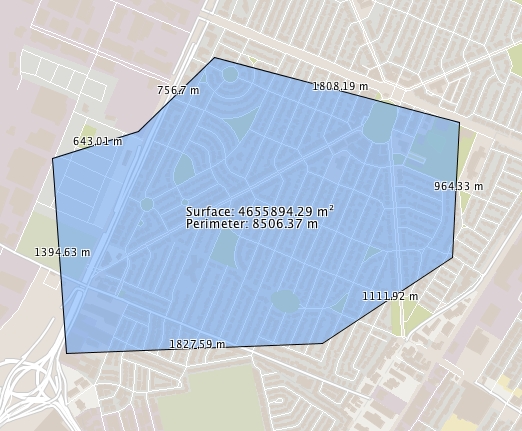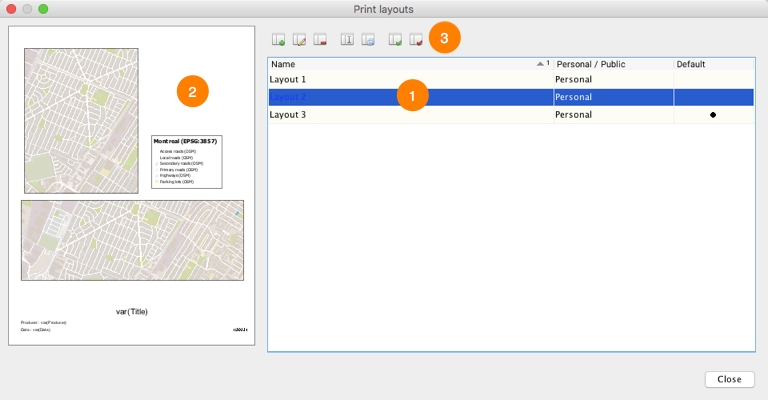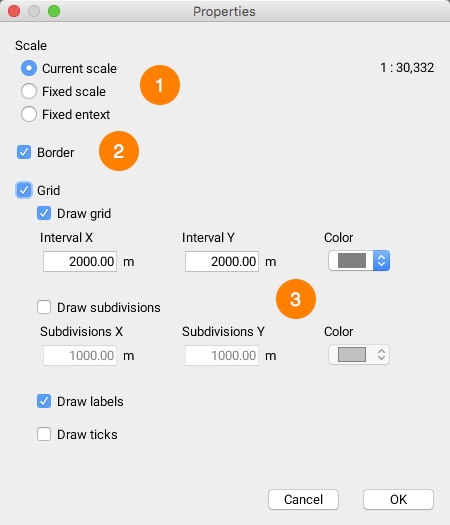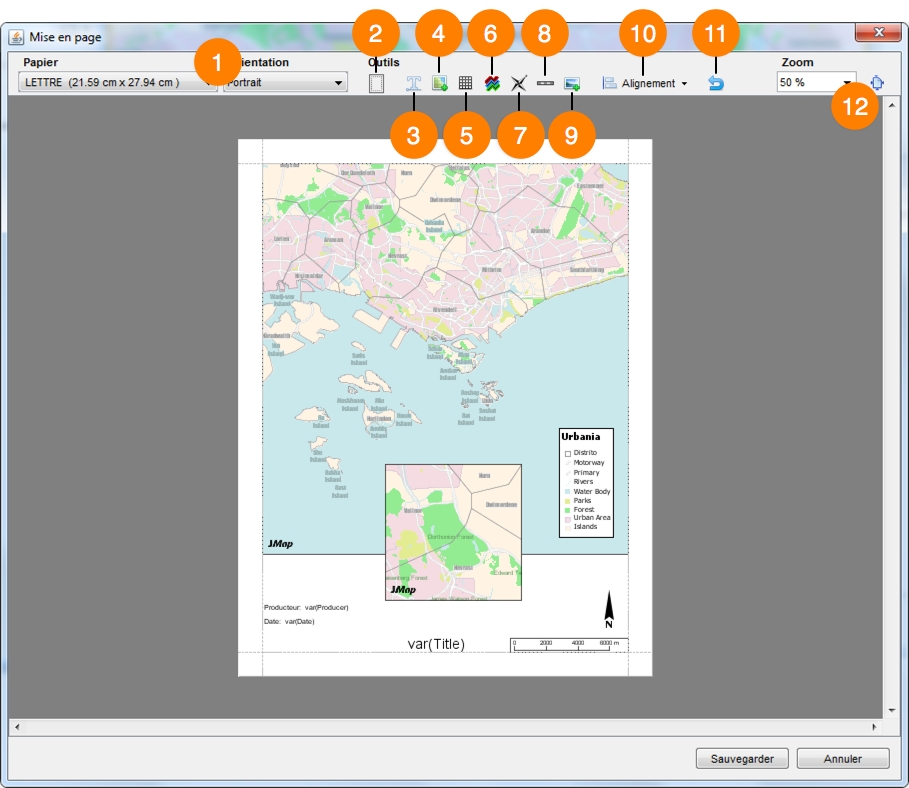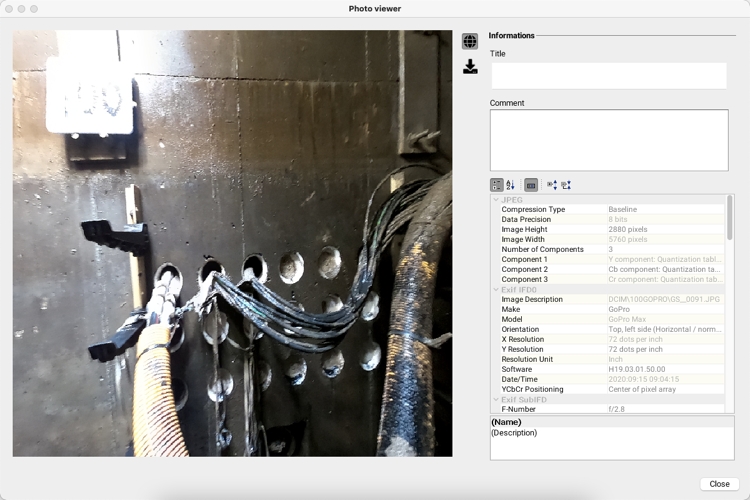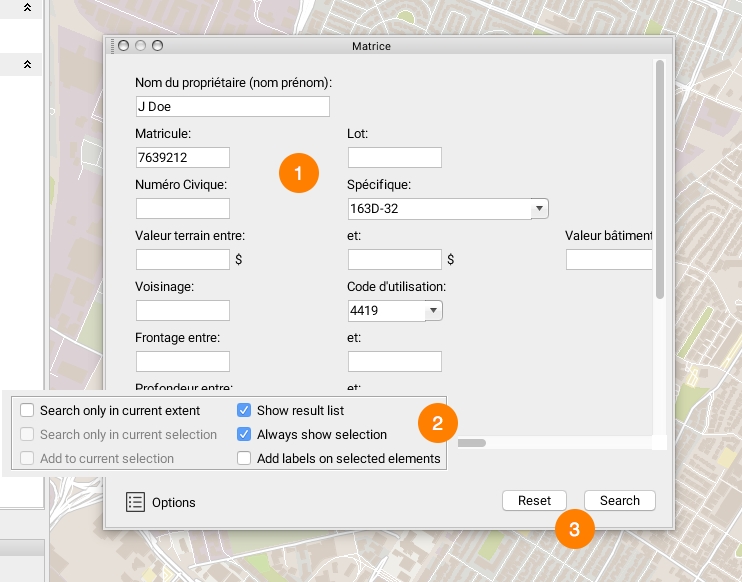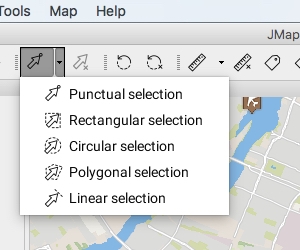
Loading...
Loading...
Loading...
Loading...
Loading...
Loading...
Loading...
Loading...
Loading...
Loading...
Loading...
Loading...
Loading...
Loading...
Loading...
Loading...
JMap includes several tools that provide information on map elements.
Several tools allow you to work with map layer data.
The tools of the Edition extension allow you to edit layer data, i.e. add elements, modify their geometry, location or attributes or delete them.
To be able to edit a layer, you must have editing permissions granted by your JMap administrator.
Several tools are available for collaborative work.
You can select elements on vector layers only. The selected elements can be used to perform various actions, such as running an information report, spatial analysis, editing, etc. Several selection tools are available.
Note that to select layer elements, the layer must be selectable (refer to the section on Layer Settings).
The following figure shows the list of available selection tools.
The number of selected elements is always indicated at the bottom of the map.
Select a single element by clicking on it. When several elements are superimposed, only the top one is selected.
Select one or more elements by tracing a rectangle. All elements that are completely or partially included in the rectangle are selected. The rectangle's dimensions are displayed.
Select one or more elements by tracing a circle. All elements that are entirely or partially included in the circle are selected. The circle's radius is displayed.
Select one or more elements by tracing a polygon. All elements that are entirely or partially included in the polygon are selected. The dimensions of the polygon are displayed.
Select one or more elements by tracing a line. All elements on the line's path will be selected.
This option does not work with map points.
Unselect all selected elements on the map.
Using any selection tool, you can press and hold the CTRL key to add or remove elements in an existing selection
Selection tools are compatible with the snap function (refer to the Snap section).
The selection explorer displays the attributes that are bound to the selected elements in the layers. Each layer is represented by a tab.
The interface allows you to access all selected elements at any time, regardless of the layer they belong to.
The selection explorer functions in a similar way to the elements explorer except that it only presents the map's selected elements (refer to the Elements Explorer section).
The figure shows the selection explorer interface:
1
Each layer that contains selected elements is represented by a tab, which indicates the name of the layer and the number of selected objects.
2
A message indicates the total number of selected objects and the number of layers the selection spans.
3
All elements that are listed are selected. If you unselect an element, it disappears from the table.
Most of the tools for drawing map objects (measurement tools, selection tools, editing tools, etc.) can be used with the snap function, which snaps the pointer to existing elements. This is useful to measure the exact distance between two elements, for example.
The menu found on the status bar of the map displays the parts of elements on which you can snap the pointer.
Press the arrow to open the menu and select by checking the snap options.
Click on to enable the snap feature. The icon goes dark.
Press the icon again to disable the function. Your snap options remain selected.
You can snap the pointer to the closest line on the map. The black x indicates the snap position.
You can snap the pointer to the closest node on the map.
This option allows you to snap the pointer in the middle of a line or of a polygon's segment.
This option allows you to snap the pointer at the intersection of two lines.
This option allows you to snap the pointer to a line or polygon segment perpendicularly.
In JMap, labels are text values attached to map elements. They are used to display the attribute values of a layer's elements. For instance, labels can display street names on a linear road system or names of cities represented on the map by points.
Labels can either be placed manually or generated automatically by JMap when the data is displayed. The labeling tool is only used for manually created labels.
Allows you to manually create a label by clicking on a map element.
Enable the tool by clicking on .
The label is displayed according to the settings that have been configured for the element's layer.
Press to delete all labels that have been added manually.
Labels can be deleted individually by doing the following: 1. Enable the labeling tool. 2. Press and hold the ALT key and click on the label you wish to delete.
This tool opens an information report related to the map elements.
Reports display descriptive data pertaining to the pointed elements. They are defined by the JMap administrator.
Enable the tool and click on one of the map's elements. If several elements of one or more layers are pointed, several reports will be available in the same window, but only one can be viewed at a time.
The figure illustrates information reports on two layers:
1
The top portion of the report displays the names of the layers for which information reports are available at the pointed area.
2
Clicking on a given layer allows you to view its list of available reports; the first report is automatically displayed.
3
The contents of the displayed report can be exported towards an Excel file or printed. There are also more advanced reports that allow you to export individual attributes to a CSV file.
4
Information contained in the report is configured by the JMap administrator.
It can originate from the layer itself or from other data sources associated with the map layer.
This tool allows you to open an information report containing information on all of the selected elements. Select elements and open the report by clicking on the information reports icon.
The figure shows an exemple of information report on selection:
1
The names of the layers on which selections have been performed are displayed at the top of the report.
2
Clicking on a given layer allows you to view its list of available reports; the first report is automatically displayed.
3
The contents of the report displayed can be exported in individual columns to a CSV file, exported in whole to an Excel file, or printed.
4
Information contained in the report is configured by the JMap administrator. It can originate from the layer itself or from other data sources associated with the map layer.
This tool allows you to obtain information on the geometry of the map's elements. The information varies according to the type of geometry (point, line, polygon, etc.) and the number of selected elements. Select one or more elements on the map and click on the button for this tool.
The figure shows the geometry information on a single map element:
The figure shows the geometry information on multiple map elements:
Mouseover bubbles contain information on map elements. They are automatically displayed when the mouse pointer remains on the elements of certain layers. Mouseover bubbles can contain attribute values, links to web pages, images, etc. When several elements are superimposed, mouseover bubbles display the information for all the elements, grouped by layer.
Mouseover bubbles can be used to display HTML content, images or 360 degree photos. When the mouseover contains many photos or large photos (such as 360 degree photos) it may have a delay in its display.
You can display the title of a photo and its comments by double-clicking on it to open the photo viewer.
The photos available for the item are displayed in the viewer. Click on the photo of your choice to display it with its information.
In the case of 360 degree photos, information about the photo can be displayed and you can navigate the photo.
The colour of mouseover bubbles can be configured (refer to Layer Settings). It can be different for each information layer.
Mouseover bubbles can be pinned to the screen in order to be displayed persistently. To pin a mouseover bubble, click on the icon located in its upper left corner.
You can select and copy the contents of a mouseover bubble by clicking on the icon located in its upper left corner and pasting it in another document (Word, Excel, etc.) using the Ctrl-C and Ctrl-V keyboard shortcuts.
You can also adjust the delay before the mouseover bubbles appear, according to your preferences (refer to the Application Settings section).
When the mouseover contains many large photos, it takes more time to display.
JMap allows you to create and share map images. You can copy a map to the clipboard and paste it into another application, send a map by email or save an image of the map in a file. These functions are accessed via the map's pop-up menu (right-click on the map).
You can copy a map to the clipboard and paste it to another application (word processor, presentation software, email, etc.). Access the pop-up menu by right-clicking on the map and selecting Share... -> Copy to clipboard. Afterwards, you can use the Paste function in the application that will receive the image.
You can save a map image in a file. Use the pop-up menu by right-clicking on the map and selecting Share... -> Save as.... You must then select a target directory and enter a name for the file.
JMap allows you to send an image of a map by email. Use the pop-up menu by right-clicking on the map and choosing Share... -> Mail this map. You can select JMap users to whom you wish to send the map or enter the recipients directly in the designated field (use a semicolon (;) to separate addresses). Groups can be used as lists of recipients. The map will be added to the email as an attachment.
Map contexts are comprised of all the settings required to recreate a geographical map. They allow you to save a map and also share it with other users. Existing contexts can be easily retrieved to recreate a map environment. All layer settings, annotations, thematics, selections, etc. are part of the context and are recreated when it is opened.
A context is associated with the project in which it was created. It cannot be accessed from other projects.
To create a new context go to Project -> Contexts... and click on from the context window.
The new context appears in a list of the user's private contexts.
Open the context management window in Project -> Contexts....
The context management window displays the list of existing contexts for the current project. The list is divided into 2 sections: the private section displays your list of private contexts (which only you can access) and the public section shows the list of public contexts (shared by users and accessible to all users who have access to the project).
Contexts can be sorted by clicking on the column headers in the list.
Open the context management window in Project -> Contexts....
JMap allows you to send a copy of a map context to one or more users. The context will appear in each recipient's private section. Recipients are the owners of their copies and can modify or delete them.
Select one or more users or groups who will receive a copy of the context. When groups are selected, all members receive a copy. Press Ok.
Open the context management window in Project -> Contexts....
A public context appears in the public section. A public context is in fact a private context that a user has decided to share with the other persons who have access to the project; all of these users can open the public context. Once it is shared, the context remains in the user's private section, and a copy of it appears in the public section. Only the user who shared the context can modify or delete it.
Open the context management window in Project -> Contexts....
Only the owner of a public context can delete it.
A context that has been deleted cannot be restored.
Open the context management window in Project -> Contexts....
A context (private or public) can be loaded automatically when opening a project.
Select the context to be loaded automatically when the project is opened. Only one project can be selected. To cancel this function, simply re-click in the check box of the selected context.
Enable the tool clicking on and click on an element in the map.
Enable the tool clicking on and trace a rectangle on the map.
Enable the tool clicking on and trace a circle on the map.
Enable the tool clicking on and trace a polygon on the map. Double-click or press the spacebar to complete the polygon.
Enable the tool clicking on and trace a line on the map; double-click or press the spacebar to complete the line.
Enable the tool clicking on .
The icon allows you to display the photo in 2 or 3 dimensions. The icon allows you to download the photo.
To view the photo in two dimensions, click on . To return to the 360 degree view, click on the same icon.
You can also disable all mouseover bubbles on the map by clicking on the button located in the lower left part of the map.
To open a context, select the context in the list and press or double-click on the context in the list. After a context is opened, the active view displays the map. The context window stays on the screen to allow you to open another context.
In order to send a context, select it in the list and press Send a copy . A window displays, allowing you to select recipients.
To make a context public, select it in the list and press Make public .
To delete a context, select it in the list and press Delete .
1
Choose the email recipient among all JMap users by clicking on the To... button or enter the address of the recipient. Enter a subject for your email.
2
Choose the image format to apply to the email attachment. You can also enter text that will accompany the map image.
1
Enter a name for the context. If the name already exists, you will be prompted for a confirmation before overwriting the context with the same name. When creating a new context, the settings of the displayed map are saved according to the selected options.
2
The following options are available: Annotations: Include the list of selected objects, the user's drawings, the labels added to the map, and the distance and surface measurements. Measures: Include measurements made on the map. Layers settings: Include layer settings (visibility, order, styles, filters, etc.). User labels: Include labels displayed on the map. Markers: Include markers for the points the user has searched for and located by entering coordinates. View settings: Include settings of the displayed map (scale, area displayed, units, etc.). If an option is not selected, the settings associated with it are ignored and are not part of the context. When the context is opened, these settings will not be affected. Certain options may not be available if they do not apply.
1
The following options are available: Open: Select the context to open and click on the button to display it. Save context...: Click on this button to create a new context from the displayed map. Delete: Select the context to delete and click on the button to delete it. Make public: Select the context you wish to make public and click on the button to make it accessible to all users. Send a copy: Select the context you wish to send and choose the recipient in the list. The recipient will then see a pop-up in JMap notifying him or her that a context has been added to his or her list of private contexts. Change projection: This advanced function allows you to change the projection associated with a context. This can be useful after an administrator has changed the projection of a JMap project.
2
Click on the tab associated with the list of contexts to be viewed (public or private).
3
When entering a query in this search field, only the contexts whose names include the contents of the query will be displayed.
4
List of contexts showing the author and creation date of each context.
5
Allows you to select a context that will be displayed by default when a JMap session is opened. Only one context can be defined with this option.
6
Information on the context that is entered when it is created, along with a preview of the context.
Search tools allow you to find elements on the map using spatial (spatial query) or descriptive (attribute query) criteria.
Attribute queries are defined in advance by the JMap administrator.
The search window displays all available queries.
Spatial queries are used to search for map elements of a layer that meet a spatial criterion.
Several types of spatial criteria are available, but each uses a reference selection as a basis for the search.
Before performing the spatial query, it is essential that you select the reference elements.
Some examples of spatial queries:
Select properties located at less than 500 meters from the selected park.
Select route segments located within the selected zoning polygon.
Select all lots adjacent to the selected river.
1
Select the information layer on which the search is performed (what you are looking for). The spatial query can only be performed on a selection that has been made beforehand.
2
Press the Options button to display a list of search options. The following options are available: Search only in current extent: The search is performed only on the area that appears on the screen. Search only in current selection: The search is performed only among the elements that are already selected. Add to current selection: The results of the query will be added to the elements on the map that have already been selected. Show result list: Displays the results list in the elements explorer. Always show selection: Displays results, even when these do not fall within the visibility thresholds of the layers that are queried (this is useful when results span a very large territory). Add labels on selected elements: Displays a label on each element that is found (improves visibility of results).
3
Choose the spatial criteria to apply for the query.
4
Press Search to launch the query.
Results are selected on the map. If the Show result list option is selected, the elements explorer displays the elements returned by the query. It is then possible to launch an information report pertaining to the selection (refer to Information Report).
Attribute queries are used to find specific elements on a layer using the layer's attribute values.
By entering search parameters in the search form (defined by the system administrator), a query is performed in order to select the map elements meeting the criteria and display them in the elements explorer.
Contact your system administrator for more information on available queries.
Measurement tools allow you to calculate distances and surfaces (area and perimeter). Measurements remain on the map until they are erased, allowing you to make several measurements, to print these with the map and save them in map contexts.
The distance measurement tool allows you to calculate the distance between two points at a bird's eye view. The tool allows you to measure multiple segments; you then obtain the distance of each individual segment as well as the total distance of all segments. The measured distances are persistent, meaning they remain on the map until the user erases them.
Enable the tool clicking on .
Click on the desired area of the map once to get started.
Click on the desired area of the map to complete each segment.
Double-click on the map or press the spacebar to complete the measurement and display the total distance.
The surface measurement tool allows you to measure areas and perimeters by tracing a polygon on the map. The measurements are persistent, meaning they remain on the map until the user erases them.
Click on the desired area of the map once to get started.
Click on the desired area of the map to complete a segment; repeat if desired.
Double-click on the map or press the spacebar to close up the polygon, complete the measurement and display the results.
Measurements can be erased one at a time by following these steps:
Enable measurement tool (distance or surface).
Press and hold the ALT key.
Click on the measurement you wish to erase.
Results are selected on the map. If the Show result list option is selected, the displays the elements returned by the query. It is then possible to launch an information report pertaining to the selection (refer to ).
Enable the tool clicking on .
Measurements remain on the map until they are erased. Press to erase all of them.
Measurement tools are compatible with the snap function (refer to ).
To obtain the geometric properties of a map element (length, area, centroid, etc.), you can use the tool instead of the measurement tool.
1
Enter data in the form's fields. In this example, select the name of the element you are searching for in the list. You can type just a few letters; the list will show the values that contain them.
2
Press the Options button to display a list of search options. The following options are available: Search only in current extent: The query will only be performed in the visible area on the screen. Search only in current selection: The query will only be performed in the elements that have been previously selected. Add to current selection: The results of the query will be added to the elements on the map that have already been selected. Show result list: Displays the results list in the elements explorer. Always show selection: Displays results, even when these do not fall within the visibility thresholds of the layers that are queried (this is useful when results span a very large territory). Add labels on selected elements: Displays a label on each element that is found (improves visibility of results).
3
Press Search to launch the query. Press Reset to reset the form.
JMap's printing tool allows you to print maps with advanced page setup options.
The print layouts are predefined page setups you can use for printing purposes. You can create your own layouts, and the JMap administrator can provide layouts that can be used by all users.
You can also ask the JMap administrator to make your personal layouts public.
The settings made in the print interface are saved automatically when you close your session.
1
2
Select the paper format and the printing orientation. JMap can print maps on many different paper formats, from very small to very large.
3
Select the print quality and type (color or grayscale). A high-quality print requires more time.
4
5
Variables are text that is replaced by user-defined values when the map is printed. The table shows all variables that are available in the selected layout. To modify a value, double-click on it and enter the new value.
6
7
Print layouts are used to define the page setup for printing. You can create your own layouts and use them according to your needs. Layouts also allow you to define a wide variety of display options. When defining the page setup of a layout, each element of the layout can be moved and resized using the mouse. Each element has its own settings window that can be accessed by double-clicking on the element.
To open the templates window, click on the Print layouts option in the Printing tools from the toolbar, or click on the Layouts... button in the Print window.
1
The list of existing layouts. The default layout is indicated in the right column.
2
A preview of the selected layout.
3
Click on these buttons to:
The map's printing properties can be configured directly in the printing interface, or they can be defined when configuring a print layout. In the latter case, double-click on one of the layout's maps and open its Properties window. Both methods offer the same options to control the map's appearance for printing purposes.
1
Scale Printing can be done according to the scale displayed on the screen or according to the displayed region.
If you choose the Current scale option, JMap will print the map according to the same scale as displayed on the screen, but the area printed can change, depending on the size of the map and paper. If you choose Fixed scale, you can enter a different scale. The Fixed extent option allows you to adapt the map to the paper format used to ensure the printed area is at least as big as the area displayed on the screen.
2
Border This option allows you to add a border around the map.
3
Grid You can add a grid on the map. This grid will show divisions and subdivisions of the coordinates system.
The map's page setup can be configured directly from the printing interface or when creating or modifying a layout. In both cases, the interfaces offer the same tools. The following figure shows the layout configuration window.
1
Select the paper format and orientation of the layout.
2
Define the margins used in the layout.
3
Click on this button to add a text element on the page.
The new element appears in the upper left corner of the page.
Double-click on the text to modify its parameters (text, alignment, font, etc.).
To insert a variable in the text, use the following syntax: var(name) , where name is the name of the variable. This function will be replaced by the value of the variable.
4
5
Click on this button to add a table on the page. Each cell of the table can contain text. Double-click on the table to access its parameters window.
6
Click on this button to add a legend on the page. The legend can be customized to display only the desired layers. Double-click on the legend to access its parameters window.
7
Click on this button to add a north arrow on the page. The arrow can be customized. Double-click on the arrow to access its parameters window.
8
Click on this button to add a graphic or textual scale on the page. Double-click on the scale to access its parameters window.
9
Click on this button to add an image on the page. You must choose an image by navigating through the file system of your computer. Double-click on the image to access its parameters window.
10
If you select one or more elements, this button allows you to align them to the page's margins and place them in the page. If you select several elements, you can also align them in relation to each other.
11
Click on this button to reset the page setup.
12
Double-clicking on the map displayed opens the Map Printing Properties window.
Select the layout you wish to use. There is always at least one default layout. Refer to for more information on layouts.
This section allows you to configure aspects such as the scale, borders, and grid of the map. For more information, refer to the section.
You can modify the page setup of the map using a preview of it. For more information, refer to the section.
Click on Layouts... to open the layout management window. Refer to the section for more information on layouts.
Create a new layout.
Edit selected layout.
Delete selected layout.
Rename selected layout.
Duplicate selected layout.
Assign selected layout as default layout.
Remove default layout status from selected layout.
Click on this button to add an additional map on the page. By default, the map that is active when the print function is executed will be displayed in full size. However, all maps that are open in JMap Pro will also be available for the creation of the layout. When you add a map on the page, double-click on it to access its parameters window and select the map to display. For more information, refer to .
You can adjust the zoom in the layout window to define the size of the page or click on to adjust the page to the size of the window.



